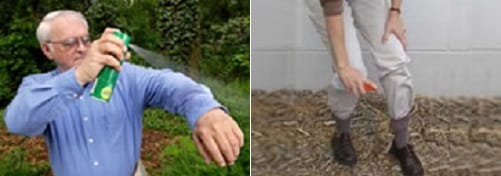Lyme Disease: Recommendations for Employers

Images courtesy of CDC Public Health Image Library, CDC Division of Viral and Rickettsial Diseases and the CDC Division of Vector-Borne Infectious Diseases
Recommendations for Employers
Employers should protect their workers from Lyme disease by taking these steps:
- Provide training for workers that includes information about the following:
- How Lyme disease is spread
- The risks of exposure and infection
- How workers can protect themselves from ticks
- The importance of the timely reporting of workplace illnesses and injuries
- Recommend that workers wear light-colored long-sleeved shirts, long pants, socks, and hat when possible.
- If worker uniforms are provided, provide long-sleeved shirts and long pants as options.
- Provide workers with Environmental Protection Agency (EPA)-registered insect repellents containing DEET, picaridin, IR3535, Oil of Lemon Eucalyptus (OLE), para-menthane-diol (PMD), or 2-undecanone.
- Provide workers with insecticides (such as permethrin) to provide greater protection. Permethrin kills ticks and can be used on clothing (but not skin).
- When possible, have workers avoid working at sites with woods, bushes, tall grass, and leaf litter.
- When avoiding these sites is not possible, personal protective measures are of particular importance. If work in these higher-risk sites must occur, take the following steps to reduce tick populations:
- Remove leaf litter.
- Remove, mow, or cut back tall grass and brush.
- Control rodent and small mammal populations.
- Discourage deer activity.
Recommendations for Workers
Take the following steps to protect yourself from tick bites:
- Wear a hat and light-colored clothing, including long-sleeved shirts and long pants tucked into boots or socks.
- Use Environmental Protection Agency (EPA)-registered insect repellents containing DEET, picaridin, IR3535, Oil of Lemon Eucalyptus (OLE), para-menthane-diol (PMD), or 2-undecanone.
- EPA’s search toolexternal icon can help you find the product that best suits your needs.
- Always follow product instructions.
- Treat clothing and gear with products containing 0.5% permethrin.
- Permethrin kills ticks on contact.
- Permethrin can be used to treat shoes, clothing, and gear but should not be used on skin.
- One application of permethrin to pants, socks, and shoes remains protective through several washings.
- Alternatively, permenthrin-treated clothing is available.
- Check your skin and clothes for ticks every day. The immature forms of these ticks are very small and may be hard to see.
- Remember to check your hair, underarms, and groin for ticks.
- Immediately remove ticks from your body using fine-tipped tweezers.
- Grasp the tick firmly and as close to your skin as possible.
- Pull the tick’s body away from your skin with a steady motion.
- Clean the area with soap and water.
- Removing infected ticks within 24 hours reduces your risk of being infected with the Lyme disease bacterium.
- Wash and dry work clothes in a hot dryer to kill any ticks present.
- Learn the symptoms of Lyme disease.
If you develop symptoms of Lyme disease seek medical attention promptly. Be sure to tell your health care provider that you work outdoors in an area where ticks may be present.
Page last reviewed: August 3, 2017
Content source: National Institute for Occupational Safety and Health
